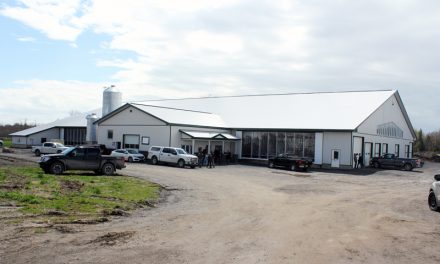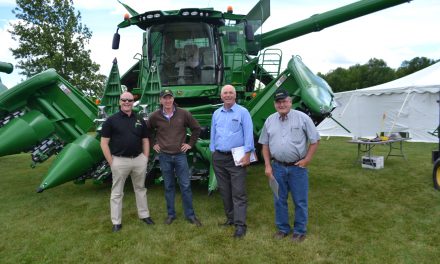Bri-Mc Farms owner Brian McIntosh harvests this strip of oats with his binder pulled by two of his draft horses. The harvesting was part of the Leeds County Draft Horse Club’s annual get together. Morin Photo
INKERMAN – Reading about the history of farming in Ontario is a little different from actually stepping back and experiencing what it was really like a few generations ago.
Members of the Leeds County Draft Horse Club get together from time to time to harvest a field using their draft horse and antique equipment.
On the Aug. 7 weekend, a group of club members and their families got together at the Bri-Mc Farms farms in Inkerman to harvest some oats, have some fun and socialize.
Brian McIntosh owner of Bri-Mc Farms and an avid draft horse and antique farm equipment owner said, “Some of our members get together and I have the property equipment, and horses, and it in activity to educate entertain and visit.”
The event attracts many retired farmers who used this same equipment as teenagers. There were several old timers ages 85,95, 82 and 75 years’ old at the field event.
The group had a binder pulled by two of the draft horses, a horse drawn wagon used to carry the stooks of cut oats to the thrashing machine, which was a Forano ME 378 Thrasher. The oats, once separated by the thrasher, were bagged and saved for later use and the straw left behind will be used for bedding.
The field days give all the participants an opportunity to remember and actually harvest the way their grandparents probably did, and they learn something each time they had, out with their equipment and horses.
“I am learning how to run this binder and through the years I have learned to run the thresher. When something breaks that’s when you learn,” said McIntosh who was driving the binder during the harvest.
Greta Shire is a four-month-old horse that is in training. She does not like to be away from her mother for very long, so when her mother is pulling the binder with another draft horse she is tied alongside her mother, and she goes through the same instructions and maneuvers her mother does.
McIntosh explained, “She is learning, and she does not want to be away from her mother, so I tie her to her mother, and she goes up and down the field with her; she will remember.”
Pulling the binder looks like an easy job for the large draft horses but McIntosh said normally he would have three horses pulling the machine.
“A binder this size should have three horses, but the two I have work well together.
This is ground driven. You have three canvases that you’re turning. The wheels you are turning and the knotter. They are driving all of that from one ground drive wheel.
“They amaze me every time we work,” he said.
“My grandfather stopped binding and thrashing in 1978. He was one of the last ones from around here. The Mennonites and the Amish still do it,” said McIntosh.
The equipment used would be the kind of machinery used by most farmers just before the invention of the modern combine.
“The reapers cut it into bundles, but they do not tie it. You come behind with a piece of straw or a string and tie it. A person following the binder would gather the cut oats into stooks and then a horse drawn wagon would follow them and collect the stooks and take them to the thrasher to be processed.
“I love these antiques,” said McIntosh. “I do not want to keep them hidden; I want to use them.”













